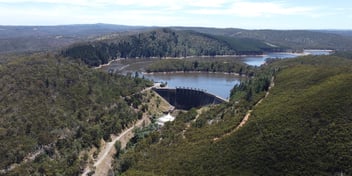Could palaeoclimate data be the key to climate change adaptation?
While some climate data allows us to gauge the likelihood of future extreme weather events, climate change is altering our understanding of what is extreme and one hydrologist says taking a more comprehensive look at our past may help prepare us for the worst.
Presenting at the Australian Water Association NSW Conference next month, University of Newcastle School of Environmental and Life Sciences Associate Professor Anthony Kiem said assessing both climate variability and climate change is crucial to future water management planning.
“The distinction between climate variability and climate change is that climate variability is natural, whereas climate change refers to human-induced or anthropogenic climate change,” he said.
“Prior to about 2000, climate variability was the main thing water resource managers considered. You made sure your water supply systems could cope by looking back through the historical observations from the last 50-100 years and prepared for the worst case on record.”
However, Kiem said that despite many uncertainties the effects of climate change are projected to change the risk of extreme weather events like floods and droughts, resulting in a need to change the way water resources are managed.
“Since anthropogenic climate change has been identified as a significant issue, it is not enough simply to deal with natural climate variability – you have to also make sure you take into account the potential impacts of future climate change,” he said.
“This requires a fundamental shift in the way water resources management is approached. One of the major impacts of climate change is that the availability of water is expected to change. The worrying thing is that we are still not really sure exactly how.
“There is a strong consensus that the next 100 years will not be the same as the past 100 years. But exactly what the next century will be like is very uncertain.”
And while uncertainty is a challenge faced worldwide, Kiem said taking a deeper look into pre-instrumental weather data – palaeoclimate records – may help us to understand what’s possible.
“It is still early days in terms of understanding the cross-roads between climate variability and climate change. All of our systems are based on instrumental records from the past 50 to 100 years. Our understanding of climate variability is limited to data from this period,” he said.
“Large amounts of palaeoclimate data covering the last 1000-2000 years has become available in the past five years. This gives us a much more extensive version of our climate history. The palaeoclimate data is telling us that the worst events on record, and in some cases even the worst case climate change projections for the coming century, are not be as bad as what has actually occurred in the pre-instrumental past,” he said.
“In this research space, we see big opportunities for using palaeoclimate records to really get a handle on what’s occurred previously and using this to give more realistic insights into what is possible in the future.”
Kiem said that using palaeoclimate events as a benchmark for future planning would enable water resource management to become more robust.
“There were some really severe, droughts and floods pre-1900 that far exceed anything we’ve seen in the past century. We are using this information to derive plausible scenarios, run that through our models and see how our current structures hold up,” he said
“If we can develop adaptation strategies that are flexible and robust enough to properly account for climate variability in the instrumental and pre-instrumental record, we will go a long way to adapting and future-proofing ourselves for whatever climate change might throw at us.”
Register for the Australian Water Association NSW Conference to hear more from Anthony Kiem on understanding climate variability and change.



